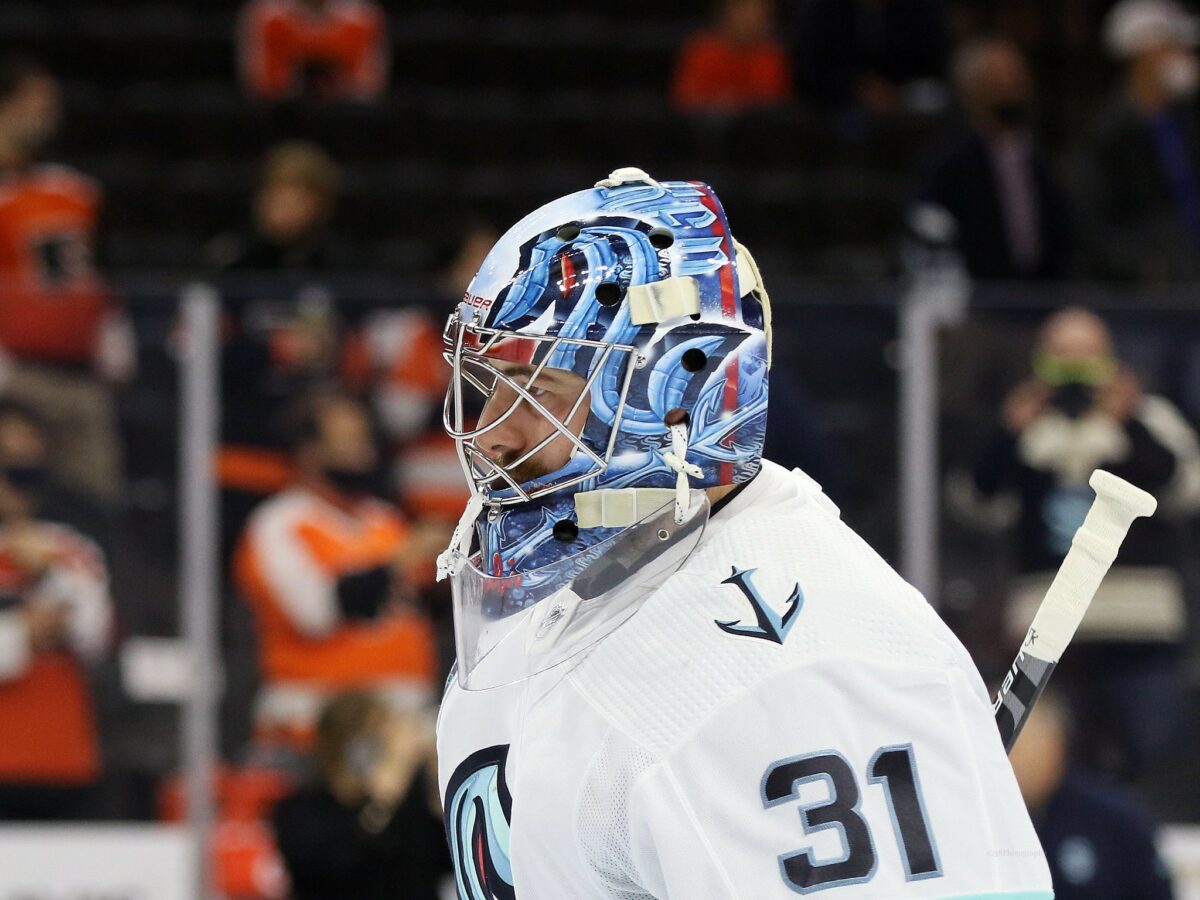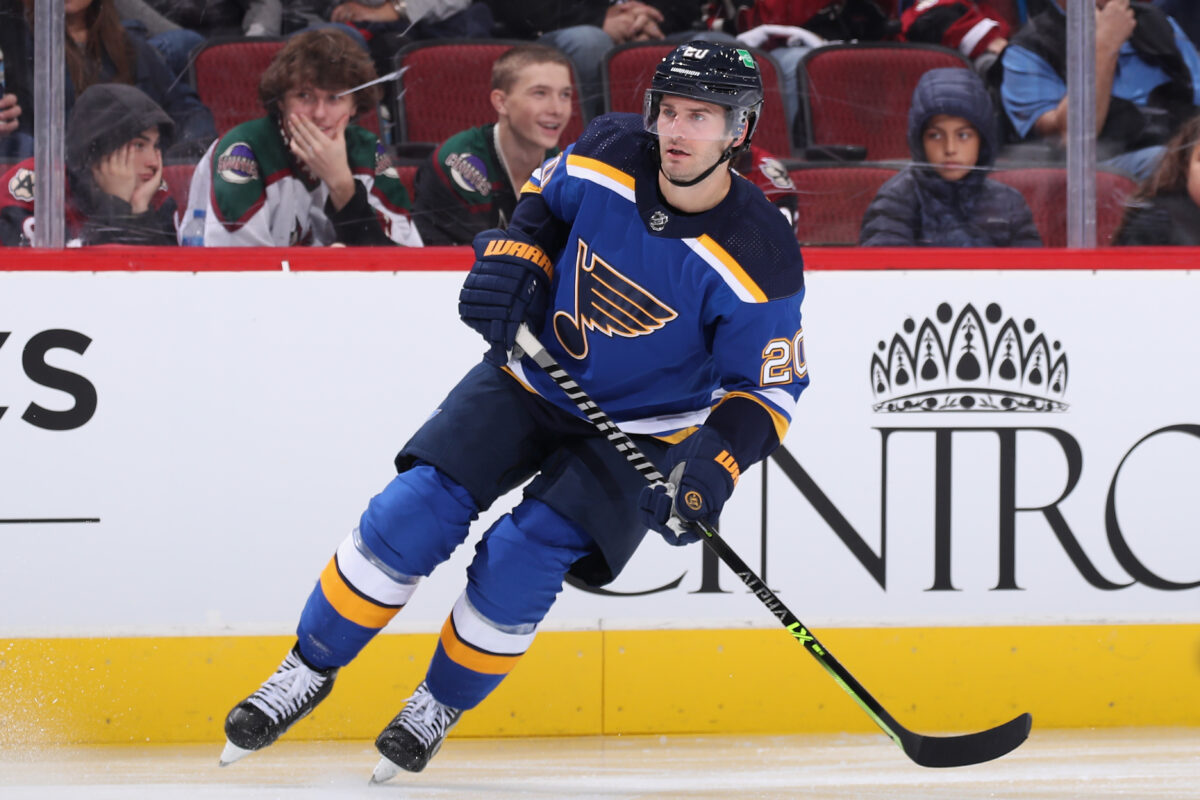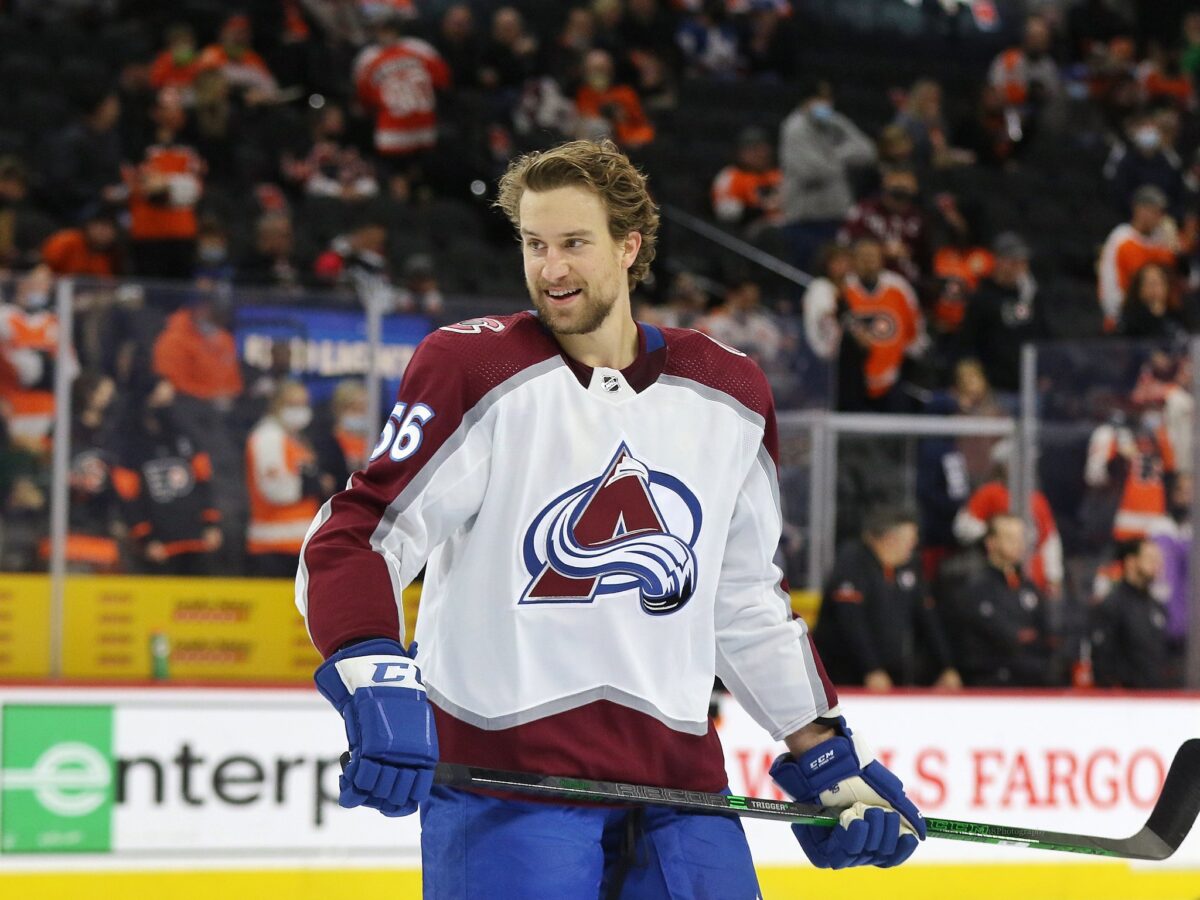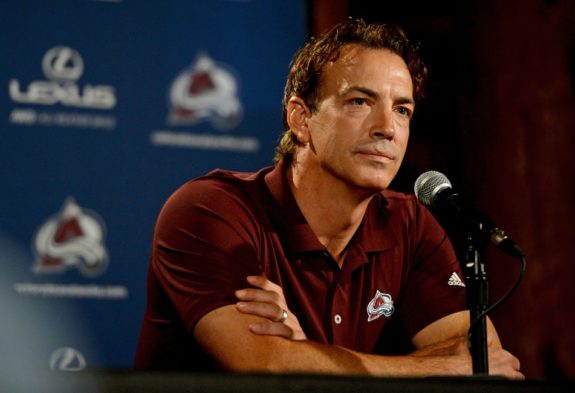After winning the Presidents’ Trophy last season, awarded to the team with the NHL’s best regular season record, the Colorado Avalanche made an early and disappointing exit from the playoffs, losing to the Vegas Golden Knights in the second round. It was the third consecutive season in which the Avalanche failed to make a deep playoff run, raising questions about the composition of the team.
Joe Sakic, the club’s executive vice president and general manager, chose to double down on his core roster, electing to make offseason moves mostly around the margins. With Colorado’s regular season at its midpoint — 41 games are in the books, and 41 games remain — this article will evaluate those moves (giving letter grades A through F), looking at the players Colorado elected not to re-sign, the players they added, and the contract extensions they awarded after the conclusion of the 2020-21 season.
Subtractions – Avalanche Players Who Did Not Return
There were four impactful departures from Colorado’s roster: Philipp Grubauer, Joonas Donskoi, Brandon Saad, and Ryan Graves. None have fared better in different environments, and at least two of them seem to have fallen on hard times.
Philipp Grubauer
The 30-year-old goaltender had a career year in 2020-21 for the Avalanche. He posted a .922 save percentage (SV%), a 1.95 goals-against-average (GAA), and recorded seven shutouts, more than double his previous best. When Colorado’s offense sputtered in the playoff series with the Golden Knights, he kept his team in games. And, of course, he was a finalist for the Vezina Trophy.

Grubauer and his representatives knew they needed to cash in on that success, and cash in they did. The native of Rosenheim, Germany signed a six-year contract with the expansion Seattle Kraken, with an average annual value (AAV) of $5.9 million.
It’s always a high-risk proposition to sign a player off a career year. (The Avalanche will face that same conundrum with Nazem Kadri this summer.) A neutral observer would have expected Grubauer to come back to Earth, at least somewhat. But the Seattle netminder has fallen much farther than that. His .883 SV%, 3.28 GAA, and zero shutouts are the worst marks of his career. It’s true that he is playing behind a substantially weaker team, but great goaltenders still find a way to perform — note Darcy Kuemper, when he was on the Arizona Coyotes. Sakic knew what he was doing when he let Grubauer walk. Grade: A
Joonas Donskoi
In last summer’s expansion draft — in which the newly minted Kraken would be able to take 20 players from other teams — the Avalanche chose to protect Valeri Nichushkin, Tyson Jost, and Logan O’Connor, exposing Donskoi, who was claimed by the Kraken.
To evaluate this move, we need to compare how those four players have fared this season.
| Player | Games Played | Goals | Assists | Points | 2021-22 Salary |
| Joonas Donskoi | 41 | 0 | 14 | 14 | $3,900,000 |
| Tyson Jost | 41 | 5 | 6 | 11 | $2,000,000 |
| Valeri Nichushkin | 25 | 11 | 10 | 21 | $2,500,000 |
| Logan O’Connor | 41 | 6 | 9 | 15 | $750,000 |
It’s clear from this chart that Sakic made the right move protecting both Nichushkin and O’Connor. Nichushkin is the most productive player on this list, putting up meaningful numbers in far fewer games. O’Connor is only slightly more productive than Donskoi, but at a much lower price. The question is, would the Avalanche have been better off protecting Donskoi, and leaving Jost vulnerable.
When you compare their stats from last season, it’s a harder question to answer. Jost had seven goals and 10 assists in 54 games; Donskoi had 17 goals and 14 assists in 51 games. Based on that information alone, the Avalanche should have protected him. After all, at least part of the reason he isn’t producing in Seattle is the team around him. That said, no goals through 41 games, along with a higher price tag, make it difficult to plead a case that Donskoi should have been protected in the expansion draft. Grade: A-
Brandon Saad
The Avalanche acquired Saad from the Chicago Blackhawks just before the start of the 2020-21 season. He was part of a four-player deal that saw Nikita Zadorov, a mainstay on the Avalanche blue line, pack his bags for Chicago. Saad came to Colorado with one season left on his contract. Despite his stellar play in the postseason — seven goals and one assist in 10 playoff games — Sakic elected not to re-sign the forward.

Saad landed on the St. Louis Blues, and has had a remarkably similar season to his 2020-21 campaign. Last season, he posted 15 goals and nine assists in 44 games played. He currently has 13 goals and nine assists in 38 games played. The AAV of his contract with the Blues is $4.5 million, which would have been difficult for the Avalanche to absorb, especially with the need to re-sign Cale Makar and Gabriel Landeskog, and the looming contract renegotiation with Nathan MacKinnon, who’s very cap-friendly deal expires in 2023.
It’s also unrealistic to believe Saad’s otherworldly play in last year’s postseason would have translated to the playoffs this year. Prior to last season, Saad had 18 goals in 81 playoff games, which is good, but not great. Saad was a solid contributor, but too expensive to keep with perhaps more downside that upside. Grade: A
Ryan Graves
Needing to protect Makar and Devon Toews in the expansion draft, Sakic has a choice: Protect Samuel Girard, or protect Graves. He chose Girard, electing to extract some value from Graves on the trade market. Graves went to the New Jersey Devils in exchange for Mikhail Maltsev and a late second-round draft pick. To evaluate this trade, we need to compare Graves and Girard.
| Player | Games Played | Goals | Assists | Points | Hits | 2020-21 Salary |
| Ryan Graves | 54 | 2 | 13 | 15 | 77 | $2,500,000 |
| Sam Girard | 48 | 5 | 27 | 32 | 31 | $5,000,000 |
Girard basically had double the production at twice the price, so perhaps it all evens out. But this season, Graves has 16 points in 36 games on a much worse team. Girard has 24 points in 39 games on the best team in the league. Graves is making $3 million this year and Girard is still at $5 million.
While Girard has better than average offensive production, and can skate circles around much of the league, he doesn’t have the same presence on the ice as Graves. Physically bigger and more imposing, Graves uses his body in ways the Avalanche defense needs. Kurtis MacDermid was brought on to play that role, but he’s been given very limited ice time. Had Sakic elected to keep Graves and trade Girard, he likely would have fetched much more than a second-round pick and back-of-the-rotation role player like Maltsev, and the defense would have retained some of its size.
Certainly not a terrible move by Sakic, but one I would have done differently. Grade: B-
Additions – Players Acquired Prior to the Start of the Current Season
Colorado added several players to compensate for those lost. Here’s a look at key members of that group.
Darcy Kuemper
With Grubauer not returning, Sakic’s highest offseason priority was acquiring a quality goaltender. He did so via a trade with the Arizona Coyotes. He sent young defenseman Conor Timmins, along with a first-round draft pick in 2022 and a conditional third-round pick in 2024, to the desert to acquire Kuemper; the veteran netminder was entering the last year of his contract. The one-year rental of Kuemper, along with sacrificing the team’s first-round pick this year, was a bold move that signaled Sakic’s intent to win now, and not play for the future.
Related: Avalanche Need Kuemper to Deliver Like Grubauer
While Kuemper was slow out of the gate, and then missed time due to both injury and COVID-19, he has come alive of late. In his last 14 games, he has a record of 11-0-1 with a SV% of .923 and GAA of 2.21. This is one move that can only be truly evaluated at the end of the season, whenever that might be. But, for now… Grade: B+.
Ryan Murray
The 6-foot-1 native of Regina, Canada, was brought in to shore up Colorado’s defense. The 28-year-old is in his ninth season in the league, and as he’s done in previous seasons, he is showing a propensity for getting injured. He’s played in only 21 games so far this season, with his average time on the ice (ATOI) only 14:15. (By contrast, Devon Toews’ ATOI is 25:33.) Murray has appeared in more than 50 games in only four of the nine seasons he’s played, so this shouldn’t be a surprise.
His cap hit of $2 million isn’t going to break the Avalanche, but in hindsight, it might have been money put to better use elsewhere. Grade: C
Kurtis MacDermid
If Nathan MacKinnon is the “Mack Attack” (that name bestowed by Avalanche radio announcer Conor McGahey), then MacDermid might be the “The Big Mack Attack.” While he’s played better the last few games (he notched his first goal of the season Wednesday night against the Bruins), the 6-foot-5, 233-pound utility man is really on this team for two reasons and two reasons only. Size and aggression.

MacDermid has an ATOI of 7:09, and has played in 29 of the team’s 41 games. Still, he leads the club in penalty minutes. While he’s tied with Logan O’Connor for fifth on the team in hits, when you adjust for the limited minutes he plays, you find that MacDermid lays a hit on an opponent an average of once every 282.75 seconds, which leads the team. The next closest is Nicolas Aube-Kubel, who records a hit every 350.19 seconds. In other words, MacDermid is doing the job he was hired to do. And at a price tag of $875,000, he was well worth the investment. Grade: A
Jack Johnson
Like Murray, Johnson was brought in to shore up the team’s defensive corps. The 35-year-old veteran is a role player whose job is to eat minutes while Makar, Toews, Girard, and Erik Johnson catch their breath on the bench. After surprising everyone with a goal in his first game in an Avalanche sweater, Johnson hasn’t scored since. He has the one goal and six assists in 37 games played. His ATOI is 16:12, which is what it should be. While the Johnson acquisition isn’t going to win Sakic a Jim Gregory Award (for NHL general manager of the year), at an AAV of $750,000, it was a worthwhile investment. Grade: B
Two other role players — Darren Helm and Stefan Matteau — are on the long-term injured reserve list, so we’ll skip the analysis for now. Aube-Kubel was acquired after the start of the season.
Avalanche Contract Extensions
Beyond the players added and subtracted from the team, Sakic was busy in the offseason negotiating contract extensions.
Cale Makar
Arguably, the most important move Sakic made in the offseason was to lock down Makar. The 23-year-old defenseman is a once-in-a-generation talent who is, in this writer’s humble opinion, the most valuable player on the Avalanche roster, even more so than MacKinnon. If he stays healthy and plays in all of the remaining games, he’s on pace to score 36 goals and 86 total points this season. The only defensemen with more goals in a single season are Paul Coffey, Bobby Orr, and Doug Wilson. The only players with more points in a season are Coffey, Orr, Ray Bourque, Phil Housley, Brian Leetch, Al MacInnis, Denis Potvin, Gary Suter, and Sergei Zubov. What do those players have in common? All but one (Gary Suter) have been elected to the Hockey Hall of Fame. Did I mention Makar is only 23?
Sakic signed Makar to a six-year deal, with an AAV of $9 million. It makes him the second highest-paid player on the team, behind Mikko Rantanen (AAV of $9.25 million). He’s not even the highest-paid defenseman in the league. Grade: A+
Gabriel Landeskog
Landeskog, the team’s captain, signed an eight-year contract extension to stay in Colorado. He likely could have found a team willing to pay more than the $7 million AAV of the current agreement, but he made it clear he wanted to play his hockey in Denver.
The $7 million makes Landeskog the third highest-paid player on the team — after Rantanen and Makar — and will slip to fourth when MacKinnon renegotiates his contract next year. That’s still not a small amount of money in a league regulated by a salary cap. But Landeskog is already rewarding Sakic by playing the best hockey of his career. He’s on pace to set career-best marks in goals, assists, and total points. He’s also a fan favorite who puts bodies in seats. This was both a great hockey move, and a great business move. Grade: A+
Logan O’Connor
Avalanche fans were delighted when Sakic offered a three-year contract extension to O’Connor, a gritty, forechecking former Denver University Pioneer. As is the case with Landeskog and Makar, O’Connor is making Sakic look good. His 15 points in 41 games is more than double his productivity over the last two seasons. Coach Jared Bednar has rewarded the undrafted forward with increased playing time, including stints on the teams vaunted top line when one of the big three (MacKinnon, Landeskog, Rantanen) have been injured. At an AAV of $1.05 million, he is clearly outplaying expectations. Grade: A

(Photo by RJ Sangosti / The Denver Post via Getty Images)
Perhaps the biggest coup is what Sakic didn’t do. He and the Avalanche ownership could have panicked after the early exit from the playoffs. They could have parted ways with Bednar, not re-signed Landeskog, traded Kadri and others. Instead, they kept the nucleus of the team together. Should Colorado make it to the Stanley Cup Final, Sakic should start polishing his mantle piece for that Jim Gregory Award. If they exit the playoffs early yet again, we’ll be having a different conversation. But for now, for the moves he didn’t make… Grade: A
